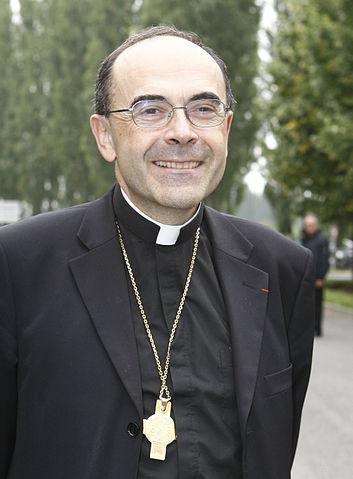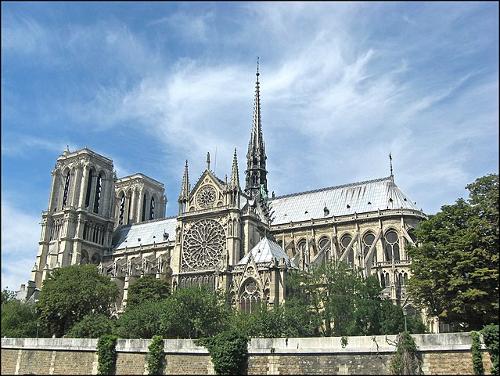LANGUEDOC-ROUSSILLON
Religion

Religion

Popular destinations FRANCE
| Alsace | Ardeche | Auvergne |
| Brittany | Burgundy | Cevennes |
| Corsica | Cote d'azur | Dordogne |
| Jura | Languedoc-roussillon | Loire valley |
| Lot | Normandy | Picardy |
| Provence |
Religion
The French population is about 80% Roman Catholic (approx. 48 million), 4.5% predominantly Sunni Islamic (approx. 4 million) and there are also small minorities of Protestants (approx. 950,000), Jews (approx. 700,000; the largest Jewish community in Europe) and Armenian-Christian. Catholicism was the state religion since the revocation of the Edict of Nantes in 1685 by Louis XIV.
Since the separation of church and state in 1905, the state no longer has any involvement with the Church. The Roman Catholic Church has eighteen provinces in France and a total of 95 dioceses. The Archbishop of Lyon is at the head of the ecclesiastical provinces. Philippe Barbarin, archbishop of LyonPhoto: MEDEF CC 2.0 Generic no changes made
Philippe Barbarin, archbishop of LyonPhoto: MEDEF CC 2.0 Generic no changes made
After St. Bartholomew's Day (1572), the power of Protestantism in France was broken. Protestant churches were not recognized until the law of 1802. The main Protestant denominations are: the Église Réformée de France, the Église de la Confession d'Augsburg d'Alsace et de Lorraine, the Église évangélique luthérienne and the Église réformée d'Alsace et de Lorraine.
Since 1905 there has been a federation of Protestant churches consisting of Reformed, Lutherans, Baptists, Methodists and free churches: the Fédération Protestante de France.
Protestant theological faculties for the training of ministers are located in Aix-en-Provence, Montpellier, Paris and Strasbourg; the last two are inter-confessional faculties. Despite the relatively small number, the influence of the Protestants in France is quite large. Notre-Dame de Paris is an early Gothic cathedralPhoto: Madhurantakam CC 3.0 Unported no changes made
Notre-Dame de Paris is an early Gothic cathedralPhoto: Madhurantakam CC 3.0 Unported no changes made
Cathars
General
The department of Aude is the land of the Cathars. The tourist slogan for this area is therefore: 'Aude, pays cathare'.
The Cathars or Albigenses (after the city of Albi) were a religious group active during the late Middle Ages in Occitania, southern France. The Cathars considered themselves to be the true Christian Church, in which Jesus was the central figure. On the basis of their dualistic views, they rejected the Old Testament. The Albigensians were regarded as heretics and bloodily persecuted by the Roman Catholic Church and the French kings.
History
From the tenth century onwards, both the Western and Eastern Churches are confronted with the rise of new dualistic doctrines. This led to severe persecution by the official Church. In Occitania, however, the Cathars could grow into a real "counter-church". The multicultural society in southern France plays a major role in this.
Catharism finds its origin in dualistic beliefs such as Gnosticism, Paulicianism and the teachings of the Bogomites from Bulgaria.
In 1145, Bernard of Clairvaux was sent to southern France to convince the Cathars to rejoin the Catholic Church. His preaching was not successful. The same should be said of the preaching in 1206 by Dominicus Guzman, the later founder of the Dominican Order.
Pope Innocent III decided that strong action should be taken against the Albigensians. In 1209, he succeeded in gathering an army for a crusade to Occitania. The French king Philip-August gives his barons permission to join the battle. He himself did not take part in the crusade.
The denial of the authority of the Catholic Church by the Albigensians, together with the secular ambitions of the pope and the conflicts between the Occitan nobility and the king, make an open war against the Cathars possible.
At first, the army was under the command of Arnaud-Amaury, abbot of Citaux Abbey. Later on, after other members of the Crusader army refused, Simon de Montfort, a low nobleman from northern France, took over the military leadership. During this crusade, the entire population of Béziers was massacred in July 1209. In July 1210, 140 Cathars were burned alive in Minerve.
With Simon de Montfort, the crusade became a real war of conquest and the contribution of the Church was relegated to second place. The religious question was relegated to the background. In June 1215 Simon de Montfort conquers Toulouse and can call himself master of southern France. In November 1215, the Fourth Lateran Council confirmed de Montfort's victory; he was given the title of Count of Toulouse.
However, he was killed in 1218. The exiled nobles, the faidits, rose up at the instigation of Raymond VII, son of the exiled Count of Toulouse Raymond VI, and drove out the crusaders in 1223. On 15 January 1224, Amaury de Montfort, the son, left Carcasonne with the last of the crusaders.
In 1226 Pope Honorius III managed to persuade the French king Louis VIII, nicknamed Louis the Lion, to lead a crusade himself. His father had always refused. Thanks to an ingenious propaganda, the faidits received the king benevolently. However, Louis VIII died the same year and the king's army was driven out of Occitania.
The new King Louis IX of France, Saint Louis, is barely twelve years old when he succeeds his father. His mother Blanca of Castile acts as regent. Initially, she has little interest in a new crusade.
In 1243, however, a third crusade against the Albigensians began. Montségur, the stronghold of the Cathars, falls in 1244. 215 Cathars are burned at the stake. In 1244, the heyday of Catharism is over.
In 1232, Pope Gregory IX orders the Dominican Order to take on the task of the Inquisition. This Inquisition was to play a major role in the persecution of the Albigensians. What remained of parfaits and croyants was cleared away. This continued until the beginning of the 14th century. The Inquisition remained active until 1321, when the last known catholic, Guillaume Bélibaste, was burned at the stake.
Naming
Most historians who wrote about the Cathars (from the Languedoc) in the course of the centuries only used the terms "Albigeois", "Albigensians".
In the medieval chronicles, the inquisition reports and the Cathar texts, the Cathars are never called "Cathars", but rather "heretics" or more positively, "good men", "good women". They themselves called themselves Christians or "friends of God".
In the middle of the 12th century the word "Cathar" appears for the first time in a sermon by the German monk Eckbert von Schonau. But he is talking about the heretics in the Rhineland who are called "Cathars". Half a century later the word is also used outside Germany in writings of opponents. Use in connection with the Languedoc is not found. Alain de Lille, a Catholic theologian, wrote in "De Fida Catholica" ("On the Catholic Faith", Montpellier 1200) among other things: "They are called Cathars from catus (cat) because they kiss a cat's behind...". Cats were associated with Satanism. In the Rhineland and also in our regions, a cat was regarded as the personification of Satan.
In 1848 Charles Schmidt, an Alsatian, wrote "Geschichte der Valdesier und Katharer"; in French the title was "Histoire et doctrine de la secte des Cathares ou Albigeois" (1848). The word "Cathar" in the sense in which we talk about Cathars today was first used in the 19th century.
In esotericism, the link was made between "cat hair" and the Greek word "catharos", which means "cleansed". An argument was found with Augustine who describes an African Manichaean sect who called themselves "catharoi" or "purified"; however, they lived in the 4th century. If at the time of the Albigensians "cat hair" had meant "catharos", it would certainly have been used by the Cathars themselves, which is not the case.
Something similar can be found regarding the word "parfait" or "perfect". The Cathar clergy did not call themselves "perfect" but simply "Christians" or "true Christians". The French word 'parfait' comes from the Inquisition. Someone who had received the consolamentum was called a 'perfect heretic' by the Inquisition, in Latin 'hereticus perfectus', later shortened to 'perfectus' or 'parfait'.
Principles of the doctrine
The Cathar doctrine is gnostic in origin. Like the other Gnostics, the Cathars are dualists, they assume that there are "two creations": the good, spiritual creation and the bad, material creation. Their vision is that the world as we know it is only a make-believe world. All material things are demeaning to the divine present in every human being.
The Cathars knew both a good and an evil God. The bad god was Yahweh, the god of the Old Testament, who created the world and imprisoned the spirits in material bodies, filling them with misery and suffering. The good god was the God of Jesus, who preached love. For the Cathars, it was completely unthinkable that God would send his own son to earth to redeem people through his suffering and death. For them, the cross was a reprehensible instrument of torture with which an attempt was made to destroy the mission of Christ. His mission was to bring the Message.
The Eucharist is not a sacrament for the Cathars. They do know the blessing of the bread at the beginning of the meal (as a reminder of Christ's mission), but they reject outright the idea of transubstantiation whereby Christ would be present in the host. For them, it is unthinkable that God could manifest himself in something as low and material as a piece of bread. The Cathars believed in reincarnation.
The Cathars knew 3 levels of commitment.
A "chrétien" had, after a novitiate, received the "consolamentum". This was the only sacrament for the Cathars. After the consolamentum he had to live according to strict regulations. He had to preach the doctrine, leave his home and family, have no sexual relations, eat no meat or dairy products, have no personal possessions, live from manual labour, do no harm or kill people or animals, swear no oaths. The "consolamentum" could only be received later in life; the Cathars believed that this had to be done deliberately, voluntarily.
A "croyant" believed in the correctness of the Cathar doctrine, but did not undergo ordination. The Cathar Church imposed no commandments or prohibitions on the croyant. This led the Roman Church to accuse the Cathars of laxity. The dying could receive a simplified form of the consolation.
An 'auditor' was one who did not believe in the Cathar doctrine, but was sympathetic to it. Most Occitan faidits (nobles) were auditeurs.
Women were administered the consolamentum slightly differently, i.e. without touching the woman. This difference was based on the philosophical premise that "women must first become men in order to attain salvation". This difference was based on the Cathars' philosophical premise that "women must first become men in order to attain salvation". This principle of subordination of female physicality is characteristic of gnostic movements. For the Cathars, however, souls were of equal value; the difference lay only in the material body.
Little children who died had not received the consolamentum. Yet according to the Cathars, they too could reach heaven; through reincarnation they were given a second chance.
Sources
Bongartz, M. / Languedoc-Roussillon
ANWB
Brutinot, L. / Languedoc-Roussillon
ANWB
Deggau, H. / Wandelgids Cevennen en Languedoc
ANWB
Encarta Encyclopedie
Graaf, G. de / Languedoc-Roussillon
ANWB
Hiddema, B. / Languedoc-Roussillon : Camargue, Cevennen
ANWB
Languedoc-Roussillon
Lannoo
Languedoc Roussillon : Gorges du Tarn, Cevennen, Carcassonne, Perpignan
Lannoo
Pijnenburg, H. / Cevennen, Languedoc
Gottmer/Becht
CIA - World Factbook
BBC - Country Profiles
Copyright: Team The World of Info